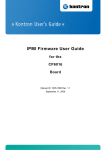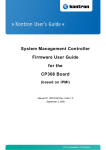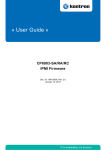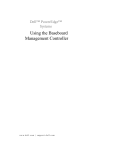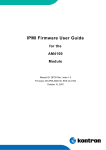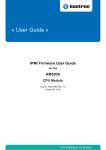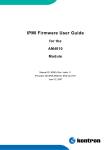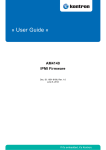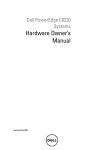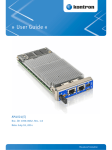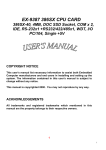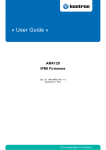Download CP6002 IPMI User Manual
Transcript
» User Guide « IPMI Firmware User Guide for the CP6002 CPU Board Doc.ID: 1039-1613, Rev. 2.0 October 26, 2012 If it’s embedded, it’s Kontron. IPMI Firmware User Guide CP6002 Revision History Publication Title: IPMI Firmware User Guide for the CP6002 CPU Module Doc. ID: 1039-1613 Rev. Brief Description of Changes Date of Issue 1.0 Initial issue 21-Oct-2010 2.0 Various minor changes incorporated 26-Oct-2012 Imprint Kontron Europe GmbH may be contacted via the following: MAILING ADDRESS TELEPHONE AND E-MAIL Kontron Europe GmbH +49(0)800-SALESKONTRON Sudetenstraße 7 [email protected] D-87600 Kaufbeuren Germany For information about other Kontron products, please visit our Internet website: www.kontron.com Disclaimer Copyright ©2010-2012 Kontron AG. All rights reserved. All data is for information purposes only and not guaranteed for legal purposes. Information has been carefully checked and is believed to be accurate; however, no responsibility is assumed for inaccuracies. Kontron and the Kontron logo and all other trademarks or registered trade marks are the property of their respective owners and are recognized. Specifications are subject to change without notice. Page 2 ID: 1039-1613, Rev. 2.0 CP6002 IPMI Firmware User Guide Table of Contents Revision History ........................................................................................................ 2 Imprint ....................................................................................................................... 2 Disclaimer ................................................................................................................. 2 Table of Contents ...................................................................................................... 3 List of Tables ............................................................................................................. 5 1. Introduction .................................................................................................... 7 1.1 Terminology and Acronym Definitions ......................................................... 7 1.2 Related Publications ................................................................................... 9 1.3 IPMI Overview ............................................................................................. 9 2. IPMI Setup .................................................................................................... 10 2.1 IPMI in a Compact PCI Chassis ................................................................ 10 2.2 IPMI Setup for the CP6002 ....................................................................... 10 2.3 IPMI Setup for the Rack ............................................................................. 11 3. Board Management Controller Hardware .................................................. 12 4. BMC Firmware ............................................................................................. 12 4.1 Key Features ............................................................................................. 12 4.2 Firmware Code .......................................................................................... 13 4.2.1 Structure and Functionality ............................................................... 13 4.2.2 Firmware Upgrade ............................................................................ 14 4.2.3 Firmware / Module Identification ....................................................... 14 4.3 The Payload Boot Process ........................................................................ 14 4.3.1 Boot Flash Selection by Writing to a Board Register ........................ 15 4.3.2 Boot Flash Selection by OEM IPMI Command ................................. 15 4.3.3 Automatic Boot Flash Selection During the Boot Process ................ 15 4.4 OS Boot Order Selection by OEM IPMI .................................................... 15 5. Communication Between the Management Controller and EFI .............. 16 ID: 1039-1613, Rev. 2.0 Page 3 IPMI Firmware User Guide 6. CP6002 Hot Swap and Shut Down ........................................................................... 16 6.1 Hot Swap Handle and Hot Swap (Blue) LED ............................................. 16 6.2 The Hot Swap and Shut Down Processes ................................................. 17 7. Setting of the SEL time ................................................................................ 18 8. XMC Card Support ....................................................................................... 18 9. Supported IPMI and ATCA Commands ...................................................... 19 9.1 Standard IPMI Commands ......................................................................... 19 9.2 AdvancedTCA and AMC Commands ........................................................ 25 10. OEM Commands and Command Extensions ............................................ 27 10.1 Get Device ID Command with OEM Extensions ........................................ 27 10.2 Set Firmware Parameters .......................................................................... 28 10.3 Set Control State (Firmware Hub, Boot Order) .......................................... 29 10.4 Get Control State (Firmware Hub, Boot Order) .......................................... 30 11. Sensors Implemented on the CP6002 ........................................................ 31 11.1 Sensor List ................................................................................................. 31 11.2 Sensor Thresholds ..................................................................................... 34 11.3 OEM Event/Reading Types ....................................................................... 35 12. FRU Data ....................................................................................................... 36 12.1 Structure and Functionality ........................................................................ 36 12.2 Board Specific FRU Data ........................................................................... 37 12.3 Downloading the FRU Data ....................................................................... 37 13. OS Support / Tools ....................................................................................... 38 13.1 Linux Tools ................................................................................................. 38 13.2 OS Support - Board Support Packages ..................................................... 38 14. IPMI Module Management LEDs ................................................................. 39 Page 4 ID: 1039-1613, Rev. 2.0 CP6002 IPMI Firmware User Guide List of Tables 1 Terminology and Acronym Definitions ........................................................... 7 2 Related Publications ..................................................................................... 9 3 Standard IPMI Commands .......................................................................... 19 4 AdvancedTCA and AMC Commands ......................................................... 25 5 Get Device ID Command with OEM Extensions ......................................... 27 6 Set Firmware Parameters ........................................................................... 28 7 Set Control State ......................................................................................... 29 8 Get Control State ........................................................................................ 30 9 Sensor List .................................................................................................. 31 10 Thresholds - Standard and E2 Temperature Range ................................... 34 11 Voltage Sensor Thresholds ......................................................................... 34 12 OEM Event/Reading Types ......................................................................... 35 13 Module Management LEDs Function .......................................................... 40 ID: 1039-1613, Rev. 2.0 Page 5 IPMI Firmware User Guide CP6002 This page has been intentionally left blank. Page 6 ID: 1039-1613, Rev. 2.0 CP6002 IPMI Firmware User Guide 1. Introduction 1.1 Terminology and Acronym Definitions The following table provides descriptions for terms and acronyms used in this guide. The descriptions are derived primarily from the IPMI specifications. Table 1: Terminology and Acronym Definitions TERM or ACRONYM BMC DESCRIPTION Baseboard Management Controller In a compact CPCI chassis, there can be only one BMC present. The BMC administrates the SEL and the SDRR for the complete system. The BMC is connected to the other boards in the shelf via a dedicated bus (IPMB-0). The CP6002 management controller can be set in SMC mode and in BMC mode by an IPMI OEM command. The factory setting is SMC. BSP Board Support Package FRU Field Replaceable Unit Every board is a FRU. The FRU data contains information about the board such as the part number and the serial number. See PICMG Specification 2.9 for complete details on the FRU data structure. The free Linux tool ‘ipmitool’ can be used to update or to display the FRU data FWH Firmware Hub Memory location where a complete EFI BIOS code is stored. I 2C Inter-Integrated Circuit IPMB Intelligent Platform Management Bus The dedicated I2C management bus where the BMC and the SMCs communicate. IPMB-0 Intelligent Platform Management Bus which connects all SMCs with the BMC or a Shelf Manager. IPMI Intelligent Platform Management Interface KCS Keyboard Controller Style (Interface) This is the IPMI mandatory interface on the host system (payload) to communicate with the BMC. MP Management Power. This powers the BMC or SMC controller. PICMG PCI Industrial Computer Manufacturer Group PWR Payload Power. This powers the host side of the board where the application software runs. It is granted by the BMC or SMC after all prerequisites are met. prerequisites are a closed handle switch, power on the backplane etc. ID: 1039-1613, Rev. 2.0 Page 7 IPMI Firmware User Guide Table 1: Terminology and Acronym Definitions TERM or ACRONYM SDR CP6002 DESCRIPTION Sensor Data Record This is the IPMI data structure that defines a sensor. SDRR Sensor Data Record Repository Is the device in the BMC where all SDRs of the chassis’ boards are administrated. A free Linux utility named ‘ipmitool’ makes a full chassis discovery and fills the SDRR with the SDRs being found. The factory default repository contains only the local board’s SDRs. SEL System Event Log Is the device in the BMC where all the events in the chassis which are reported are administrated. If an event occurs on any board, the sensor event is sent through the IPMB bus to the BMC which additionally stores its own events as well. SMBIOS System Management BIOS SMC Satellite Management Controller In a compact PCI chassis, there can be many SMCs. Each SMC is connected to the BMC via a dedicated bus (IPMB-0). The CP6002 management controller can be set in SMC mode and in BMC mode by an IPMI OEM command. The factory setting is SMC. SMS Page 8 System Management Software (designed to run under the OS) ID: 1039-1613, Rev. 2.0 CP6002 1.2 IPMI Firmware User Guide Related Publications The following publications contain information relating to this product. Table 2: Related Publications PRODUCT PUBLICATION IPMI IPMI Specification V2.0 (without LAN support) IPMI IPMI- Platform Management FRU Information Storage Definition v1.0, Document Revision 1.1 IPMI Addenda, Errata, and Clarifications document revision 4 for IPMI v2.0 rev 1.0 specification IPMI Intelligent Platform Management Bus Communications Protocol Specification v1.0 Document Revision 1.0, November 1999 IPMI IPMB v1.0 Address Allocation Document Revision 1.0, September 1998 PICMG CompactPCI System Management Specification PICMG 2.9 Rev. 1.0 CP6002 CP6002 User Guide, ID: 1036-6431, Rev. 3.0 CP6002 uEFI BIOS User Guide, ID: 1039-1612, Rev. 2.0 CP6002 CP6002 Linux Board Support Package IPMI Tools ‘ipmitool’ documentation: http://ipmitool.sourceforge.net IPMI Tools OpenIPMI documentation: http://www.openipmi.sourceforge.net 1.3 IPMI Overview This product fully supports the Intelligent Platform Management Interface (IPMI v2.0, without LAN support) and PICMG 2.9 R1.0 specifications. All of its IPMI functionality operates under an autonomous management controller even if the board is held in reset or power down by a management card within a system designed for High Availability such as XL-VHDS or XL-LP42. While the CP6002 IPMI implementation is fully compliant to IPMI v2.0 and should work with any System Management Software that respects this specification, it has been designed to be easily integrated with the Service Availability Forum-Hardware Platform Interface (SAF-HPI) specification. More information about Service Availability can be found on the following Web site: http://www.saforum.org/home IPMI is an extensible and open standard that defines autonomous system monitoring. It is autonomous because every management controller within a compact PCI chassis monitors its own sensors and sends critical events through a dedicated bus to a Baseboard Management Controller (BMC) that logs it into a non-volatile System Event Log (SEL). The CP6002 IPMI implementation includes a device SDR repository module that allows the user's System Management Software (SMS) to detect all system components and to build a database of all management controller sensors. For further information concerning IPMI refer to the following Web site: http://www.intel.com/design/servers/ipmi/ ID: 1039-1613, Rev. 2.0 Page 9 IPMI Firmware User Guide CP6002 2. IPMI Setup 2.1 IPMI in a Compact PCI Chassis Kontron's IPMI implementation in the CompactPCI environment is compliant with the PICMG 2.9 R1.0 specification. This specification defines the pinout of the J1 and J2 CompactPCI connectors as well as the addressing scheme. There should be only one BMC in the chassis, or at least on the IPMB segment. The BMC may reside either on an CP6002, or on an external system management card, or in a shelf management controller (ShMC). The specification allows all of these variants. As a BMC in the system slot, the CP6002 supports dual-ported IPMB (IPMB-0 to the SMCs and IPMB-1 to the external segments via the CompactPCI backplane connector in accordance with PICMG 2.9). Backplane IPMB 1 BMC SMC SMC SMC IPMB Address Fix: 20h IPMB Address: B0h(1) IPMB Address: B2h(1) IPMB Address: B4h(1) IPMB 0 IPMB 0 (1) SMC SMC SMC SMC IPMB Address: B6h(1) IPMB Address: B8h (1) IPMB Address: BAh (1) IPMB Address: BCh(1) IPMB address for SMC is determined via the location of the slot in the chassis To use the IPMI resources in a rack requires an initial setup for IPMI operation. The following actions must first be performed to achieve operable IPMI functionality. 2.2 IPMI Setup for the CP6002 Initially the default configuration for the IPMI Management Controller of the CP6002 is: • IRQ = none • MODE = SMC • IPMB = single-ported. If this is the required configuration, no further action is required. If the configuration must be modified, either the uEFI shell command “kipmi” or one of the open tools “ipmitool” or “ipmicmd” may be used to modify the configuration as required. Page 10 ID: 1039-1613, Rev. 2.0 CP6002 IPMI Firmware User Guide To use the “kipmi” command, refer to the CP6002 uEFI BIOS User Guide. When EFI stores the configuration, it creates an ‘IPMI Device Information Record’ entry in the SMBIOS table. This record contains information about (among others): • Type of the supported interface (KCS style) • Selected interrupt (10, 11 or none). This information is required by the CP6002 payload’s IPMI OS kernel drivers for Linux during their loading time. After the loading, most available IPMI communications tools which access the IPMI controller via IPMI OS drivers should work (e.g. ‘ipmicmd’, ‘ipmitool’, etc.). Now it is possible to use such a tool to issue the “Set Firmware Parameters” OEM IPMI command to modify the configuration again. Changing the interrupt number always requires an EFI restart for a correct set up of the SMBIOS table. 2.3 IPMI Setup for the Rack For a working IPMI configuration the SDRR of the BMC must be filled with all sensor data records of all IPMI controllers in the rack. After every system start the BMC uses the SDRR to initialize all sensors of all boards. The SDRR setup must be done by a management tool e.g. the open Linux tool ‘ipmitool’. The command then is: ipmitool sdr fill sensors This will only work if the IPMI controller of the BMC is addressed. This addressing is the default if the ‘ipmitool’ is running on the payload side of the board where the BMC is residing. ID: 1039-1613, Rev. 2.0 Page 11 IPMI Firmware User Guide 3. CP6002 Board Management Controller Hardware On the CP6002 CPU board, the BMC is implemented using the NXP ARM7 microcontroller with 512 kB of internal flash and 56 kB of RAM. An external 64 kB serial EEPROM chip is used for firmware private data and for FRU Inventory storage. An additional external 4 MB serial SPI-Flash is used for redundant firmware image storage. The Board Management Controller implements a local Keyboard Controller Style (KCS) Interface with interrupt support for communication with system side management software and the uEFI BIOS. The IPMB bus is used for interconnection with the BMC or Shelf Manager. The Board Management Controller provides access to various board sensors which permit the monitoring of: • System power voltages: 5V (PWR), 3.3V, IPMI 5V, 12V, MMC supply 4.7V • Temperatures: CPU die, graphic die, PCH, and one board temperature • Power Good, IPMB-0 link, board reset, post code, boot error, CPU States (processor hot, thermal trip, …), IPMB-L state, Health error, IPMI watchdog etc. 4. BMC Firmware 4.1 Key Features The following are key features of the CP6002 BMC Firmware: • Compliant with IPMI specification 2.0 (without LAN support) • Compliant with PICMG 2.9 specification • Firmware designed and specially made for compact PCI implementation and easy integration with SAF-HPI • KCS SMS interface with interrupt support • Dual-port IPMB support • Out-of-band management and monitoring using IPMB interface permits access to sensors regardless of the board's CPU state • Sensor thresholds fully configurable • Sensor names prefixed with identification of owner (BMC without slot number or SMC with slot number) • Complete IPMI watchdog functionality • Complete SEL, SDR repository and FRU functionality on BMC • Complete FRU functionality • Master Write-Read I2C support for external I2C devices communications (FRU, EEPROM, FAN) • Two IPMI controller firmware banks allow an automatic backup. This allows manual and automatic firmware image roll-back (in case of upgrade failure). Page 12 ID: 1039-1613, Rev. 2.0 CP6002 IPMI Firmware User Guide • The downloading of a new firmware image does not break currently running firmware or payload activities • Firmware bank management is done by the open tool ‘ipmitool’ function ‘fwum’ which can update the firmware in the field • Firmware fully customizable via OEM IPMI commands to satisfy customer requirements • FRU data can be updated in the field by the open tool ‘ipmitool’ function ‘fru write’ • Interoperable with other IPMI solutions OEM board supervision and control extensions such as boot device flash selection and firmware boot order configuration. • Automatic switching to an alternative EFI image after having detected an inoperable EFI • “Graceful Shut Down” support • Handle switch and blue Hot Swap LED operation • The I0 and I1 LEDs indicate operational status of the IPMI Firmware • The board's write protection feature for non-volatile memories is supported. These memories are: • I2C EEPROM for FRU data and parameters • SPI FLASH memory for firmware banks 4.2 Firmware Code 4.2.1 Structure and Functionality The IPMI controller firmware code is organized into boot code and operational code, both of which are stored in a flash module. Upon an IPMI controller reset, the IPMI controller first executes the boot code which does: • A self test to verify the status of the Management Controller's hardware including its memory • Performs a checksum of the operational code After successful verification of the operational code checksum, the firmware will execute the operational code. Only the operational code is upgradable in-the-field. ID: 1039-1613, Rev. 2.0 Page 13 IPMI Firmware User Guide 4.2.2 CP6002 Firmware Upgrade Firmware upgrading is only possible when write protection is not set. The standard way to upgrade the IPMI controller's operational code is to use the open tool ‘ipmitool’ together with an image file. ‘ipmitool’ allows the downloading (‘ipmitool fwum download …’) and activation (‘ipmitool fwum upgrade’) of the new operational code and saves an existing one. The rollback to the formerly running operational code is possible as well (‘ipmitool fwum rollback’). The status command (‘ipmitool fwum status’) displays what firmware is stored and in what state it is (‘last known good’ = running, ‘previous good’ = running before upgrade). All IPMI interfaces which are offered by ‘ipmitool’ except LAN are usable for the upgrade. This allows local upgrade and remote upgrade. Please note that the KCS interface is only usable with a powered payload. Files which contain an image of operational code have the firmware ID "B340" and the string "FWUM" in its name. During the download process the currently running operational code is still operating in a normal way until the upgrade command is issued. During the upgrade start, the IPMI controller is off line for about 20 seconds while the boot code re-organizes the firmware storage. Afterwards the new operational code is started. If the new operational code doesn't operate properly (e.g. hangs up) the boot code will perform an automatic rollback to the last working operational code and start this again. 4.2.3 Firmware / Module Identification There are two ways to verify by means of IPMI that a Management Controller resides on a CP6002. Invoking the IPMI command “Get Device ID” returns among other information the following data: • Manufacturer ID = 3A98h (Kontron IANA ID) • Product ID = B340 for the firmware • Firmware Revision in bytes 4:5 - depends on the core version of the running firmware. • The SDR revision in byte 13 (OEM part of the response) is a sub-revision of the firmware revision. It is unique for all versions of the board's firmware. • The Device ID String which can be found by reading the Management Controller Device Locator Record (SDR Type 12h) contains the string "BMC:x ... x". For example, invoking the ipmitool command 'ipmitool sdr list mcloc' will return the Device ID Strings of all available boards. If the CP6002 is a BMC, this string will be displayed without change. If the CP6002 is an SMC, then the string will be changed into "Sxx: x ... x" where xx is the slot number where the board is residing, e.g. "S09: x ... x". 4.3 The Payload Boot Process When the CP6002's payload starts, the first code to be executed is the EFI. There are two Flash devices, numbered 0 and 1, which may contain different EFI code. Which one of them will be utilized from the next boot process on is defined by one of two ways: Page 14 ID: 1039-1613, Rev. 2.0 CP6002 IPMI Firmware User Guide • The contents of a user (payload) writeable register (refer to the CP6002 User Guide) defines which Boot Flash to use. This is the primary selection. • The firmware's parameter EEPROM contains a parameter whose value is used to determine whether or not to invert the primary selection register's contents when the Management Controller's firmware selects the Boot Flash. For this the Management Controller sets or resets a control signal which does or does not invert the Boot Flash selection. 4.3.1 Boot Flash Selection by Writing to a Board Register Refer to the CP6002 User Guide for further information concerning Boot Flash selection using a board register setting. 4.3.2 Boot Flash Selection by OEM IPMI Command The OEM IPMI command “Set Control State” specifies whether or not the Management Controller is to invert the register based Flash selection from the next boot process on. The Management Controller stores this requirement in a parameter in the EEPROM. 4.3.3 Automatic Boot Flash Selection During the Boot Process After each payload reset the Management Controller selects the Boot Flash by applying the related EEPROM parameter. Physically the Management Controller sets or resets a signal line. Afterwards it waits for a special message from the EFI. This message contains the checksum report, i.e. it indicates the validity of the Boot Flash's checksum. If the checksum is wrong or the message is not received within 60 seconds, then the currently used EFI Flash is assumed to contain an invalid or a corrupted image. In this case, the Management Controller toggles the parameter value in the EEPROM and issues a “Boot Error (Invalid boot sector) event” by setting the appropriate sensor value (sensor 'FWHx Boot Err'. x = 0..1). x is simply the value of the parameter in EEPROM and not the absolute number of the used Boot Flash. Afterwards it causes a payload off-on cycle and continues as described at the beginning of this chapter. When a timeout error is recognized and the count of boot errors exceeds 2, or when a checksum error is recognized and the count of boot errors exceeds 4 the Management Controller makes no further attempt to reset/restart the payload. Only at the next power off/on of the CP6002, will the Management Controller again attempt to start the payload. 4.4 OS Boot Order Selection by OEM IPMI Normally the EFI will apply the OS boot order which was selected in the EFI menu “Boot/Boot Option Priorities”. But there is another alternative boot order which is stored in the Management Controller's non-volatile memory. This boot order can be set and read by IPMI OEM commands. At payload start the Management Controller writes it into a register where the EFI can read it. If this Management Controller's boot order has a non-zero value the EFI will use it instead of its own boot order. ID: 1039-1613, Rev. 2.0 Page 15 IPMI Firmware User Guide 5. CP6002 Communication Between the Management Controller and EFI For communication between EFI and the Management Controller there is a “private” KCS interface. During the boot process the EFI sends the following IPMI commands to the Management Controller: • An OEM command which reports a good or a bad checksum. • A Standard IPMI command “Set Watchdog Timer” to stop a possibly running IPMI watchdog timer. • A Standard IPMI command “Set SEL Time” to set the event log time to the time which is kept by the RTC. • The OEM IPMI command “Set Firmware Parameters” with some parameters which for example sets the Management Controller to a BMC or a SMC as selected in the EFI shell. • A Standard IPMI command “Set ACPI Power State” to set the state “ACPI legacy on” • Etc. 6. Hot Swap and Shut Down 6.1 Hot Swap Handle and Hot Swap (Blue) LED The blue Hot Swap LED (HS LED) of an inserted board in a powered rack is normally used to indicate the board's operational status so as to facilitate hot-swapping of the board: • ON The payload is inactive and may be: • Activated by closing the Hot Swap Handle, or • The board may be extracted. The “M-state” is 1. An exception is the case when payload power is off e.g. after a shut down via an IPMI chassis command and the handle is still closed. Here the M-state is 4. To show the operator that the payload power is off, the blue LED will be on in spite of the closed handle. • BLINKING Changing from active state to inactive state or vice versa. Don't extract the board now. The “M-state” is 2, 5 or 6. • OFF The payload is active. Don't extract the board now. Normally the extraction is impossible because the handle is closed and locked. The “M-state” is 3 or 4. Page 16 ID: 1039-1613, Rev. 2.0 CP6002 IPMI Firmware User Guide Normally the logical states “active” and “inactive” of a payload are identical to the physical states “handle open” and “handle closed” or “payload power off” and “payload power on”. If, however, power is switched on or off using IPMI chassis commands or the payload is shut down by the OS, then the position of the Hot Swap Handle and the power state may become asynchronous. In this case the blue LED is switched on indicating that the payload power is switched off although the handle is closed. Such actions are not part of the Hot Swap process and are governed by their own functionality which is not within the scope of this document. 6.2 The Hot Swap and Shut Down Processes Hot Swap as defined here, is the purposely initiated process to remove and replace an active board in a powered system. To accomplish this requires that the hot swap process provide for an orderly transition of the payload from the active to inactive state and vice versa. This is necessary to preclude improper system operation and possible loss of data. The CP6002 has all the necessary features including hardware and IPMI software to support hot swapping. On the software side, however, not all available OS’s support hot swapping, not even partially. Three possible cases for hot swapping based on OS capabilities are described as follows. Case 1: Involves an OS which does not support ACPI After payload power on, the starting EFI will inform the Management Controller by sending the IPMI command “Set ACPI Power State / Set Legacy on”. This means that a Hot Swap (opening of the closed handle) shall immediately lead to payload power off by the Management controller. In this event, the application/operator is responsible for the termination of all payload processes prior to initiating removal/replacement of the board to avoid improper operation or loss of data. Case 2: Involves an OS which emulates ACPI support An OS which does not really support ACPI, such as VxWorks, is able to obtain “Graceful Shut Down” support from the Management Controller by performing in the following way. After start up, such an OS must manipulate the chip set in a way that prevents an immediate power off when the “power button” is logically activated. Then it must send the IPMI command “Set ACPI Power State / S0/G0 working” to the Management Controller to enable this to process later on an “S3/G2 soft off” command. During application operation the system must cyclically read the “Hot Swap Sensor” (sensor #0) using the IPMI command “Get Sensor Reading”. This allows the tracking of the board's state. After the board has once reached “M-state” 4 (sensor reading is 10h) the leaving of this announces that the handle was opened. Now the time has come to terminate all processes. After all critical processes have been terminated, the OS must send the IPMI command “Set ACPI Power State / S3/G2 soft off” to the Management Controller which will set the power off immediately. Case 3: Involves an OS which supports ACPI When an OS is started which supports ACPI, the IPMI command “Set ACPI Power State / S0/G0 working” is sent to the Management Controller. This indicates that the OS has reprogrammed the chip set in such a manner that a “power button” signal does not lead to an immediate power off but only causes an event that can be detected by the OS. ID: 1039-1613, Rev. 2.0 Page 17 IPMI Firmware User Guide CP6002 When the handle is opened, the Management Controller asserts the “power button” signal to notify the OS. The OS then shuts down all processes and afterwards causes the transmission of the IPMI command “Set ACPI Power State / S3/G2 soft off” to the Management Controller which then switches the power off. 7. Setting of the SEL time The Management Controller does not have its own hardware real time clock. Therefore after startup, restart or upgrade of the Management Controller, its software clock first must be supplied with the current time. The Management Controller uses the time when handling event messages which otherwise will have an out-of-date time stamp. Every time when the EFI starts up, it supplies the Management Controller with the payload's current real time clock time. It is a problem with restarts of the Management Controller without a following EFI startup. Because, during restart the Management Controller's time gets lost and it must be set again by issuing the IPMI command “Set SEL Time”. This may be done by application software on the payload side via the KCS interface or by a remote Management Controller via the IPMB-0. 8. XMC Card Support The presence or absence of XMC card(s) is reported by sensors “XMC present” and “XMC-2 pres” (refer to sensor description). If an XMC card is present the card's FRU data EEPROM is readable/writable. The size of the EEPROM must be smaller or equal to 256 bytes, because of 8-bit EEPROM addressing. Note that XMC FRU size is always reported as 256 bytes and writing to locations that are higher than the real capacity should be avoided. The FRU data of the XMC can be read under Linux with: • ipmitool fru print 1 • ipmitool fru print 2 (on boards with two XMCs) Page 18 ID: 1039-1613, Rev. 2.0 CP6002 IPMI Firmware User Guide 9. Supported IPMI and ATCA Commands 9.1 Standard IPMI Commands Part of the command list in IPMI specification 2.0 M = mandatory, O = optional Table 3: Standard IPMI Commands COMMAND IPMI 2.0 SPEC. SECTION NETFN CMD IPM DEVICE “GLOBAL” COMMANDS KONTRON SUPPORT ON BMC M Get Device ID 20.1 App 01h M / Yes [1] Cold Reset 20.2 App 02h O / Yes Warm Reset 20.3 App 03h O / No Get Self Test Results 20.4 App 04h O / Yes Manufacturing Test On 20.5 App 05h O / No Set ACPI Power State 20.6 App 06h O / Yes Get ACPI Power State 20.7 App 07h O / Yes Get Device GUID 20.8 App 08h O / No Broadcast “Get Device ID” 20.9 App 01h M / Yes BMC WATCHDOG TIMER COMMANDS O Reset Watchdog Timer 27.5 App 22h O / Yes Set Watchdog Timer 27.6 App 24h O / Yes Get Watchdog Timer 27.7 App 25h O / Yes BMC DEVICE AND MESSAGING COMMANDS O Set BMC Global Enables 22.1 App 2Eh O / Yes Get BMC Global Enables 22.2 App 2Fh O / Yes Clear Message Flags 22.3 App 30h O / Yes Get Message Flags 22.4 App 31h O / Yes Enable Message Channel Receive 22.5 App 32h O / Yes ID: 1039-1613, Rev. 2.0 Page 19 IPMI Firmware User Guide Table 3: CP6002 Standard IPMI Commands IPMI 2.0 SPEC. SECTION NETFN CMD KONTRON SUPPORT ON BMC Get Message 22.6 App 33h O / Yes Send Message 22.7 App 34h O / Yes Read Event Message Buffer 22.8 App 35h O / Yes Get BT Interface Capabilities 22.9 App 36h O / No Get System GUID 22.14 App 37h O / No Get Channel Authentication Capabilities 22.13 App 38h O / No Get Session Challenge 22.15 App 39h O / No Activate Session 22.17 App 3Ah O / No Set Session Privilege Level 22.18 App 3Bh O / No Close Session 22.19 App 3Ch O / No Get Session Info 22.20 App 3Dh O / No Get AuthCode 22.21 App 3Fh O / No Set Channel Access 22.22 App 40h O / No Get Channel Access 22.23 App 41h O / No Get Channel Info 22.24 App 42h O / Yes Set User Access 22.26 App 43h O / No Get User Access 22.27 App 44h O / No Set User Name 22.28 App 45h O / No Get User Name 22.29 App 46h O / No Set User Password 22.30 App 47h O / No Activate Payload 24.1 App 48h O / No Deactivate Payload 24.2 App 49h O / No Get Payload Activation Status 24.4 App 4Ah O / No Get Payload Instance Info 24.5 App 4Bh O / No Set User Payload Access 24.6 App 4Ch O / No Get User Payload Access 24.7 App 4Dh O / No COMMAND Page 20 ID: 1039-1613, Rev. 2.0 CP6002 Table 3: IPMI Firmware User Guide Standard IPMI Commands IPMI 2.0 SPEC. SECTION NETFN CMD KONTRON SUPPORT ON BMC Get Channel Payload Support 24.8 App 4Eh O / No Get Channel Payload Version 24.9 App 4Fh O / No Get Channel OEM Payload Info 24.10 App 50h O / No Master Write-Read 22.11 App 52h O / Yes Get Channel Cipher Suits 22.15 App 54h O / No Suspend/Resume Payload Encryption 24.3 App 55h O / No Set Channel Security Keys 22.25 App 56h O / No Get System Interface Capabilities 22.9 App 57h O / No COMMAND CHASSIS DEVICE COMMANDS O Get Chassis Capabilities 28.1 Chassis 00h O / Yes Get Chassis Status 28.2 Chassis 01h O / Yes Chassis Control 28.3 Chassis 02h O / Yes Chassis Reset 28.4 Chassis 03h O / No Chassis Identify 28.5 Chassis 04h O / No Set Chassis Capabilities 28.7 Chassis 05h O / No Set Power Restore Policy 28.8 Chassis 06h O / No Get System Restart Cause 28.11 Chassis 07h O / No Set System Boot Options 28.12 Chassis 08h O / No Get System Boot Options 28.13 Chassis 09h O / No Get POH Counter 28.14 Chassis 0Fh O / Yes [2] EVENT COMMANDS M Set Event Receiver 29.1 S/E 00h M / Yes Get Event Receiver 29.2 S/E 01h M / Yes Platform Event (a.k.a. “Event Message”) 29.3 S/E 02h M / Yes ID: 1039-1613, Rev. 2.0 Page 21 IPMI Firmware User Guide Table 3: CP6002 Standard IPMI Commands COMMAND IPMI 2.0 SPEC. SECTION NETFN CMD PEF AND ALERTING COMMANDS KONTRON SUPPORT ON BMC O Get PEF Capabilities 30.1 S/E 10h O / No Arm PEF Postpone Timer 30.2 S/E 11h O / No Set PEF Configuration Parameters 30.3 S/E 12h O / No Get PEF Configuration Parameters 30.4 S/E 13h O / No Set Last Processed Event ID 30.5 S/E 14h O / No Get Last Processed Event ID 30.6 S/E 15h O / No Alert Immediate 30.7 S/E 16h O / No PET Acknowledge 30.8 S/E 17h O / No SENSOR DEVICE COMMANDS M Get Device SDR Info 35.2 S/E 20h M / Yes Get Device SDR 35.3 S/E 21h M / Yes Reserve Device SDR Repository 35.4 S/E 22h M / Yes Get Sensor Reading Factors 35.5 S/E 23h O / No Set Sensor Hysteresis 35.6 S/E 24h O / Yes Get Sensor Hysteresis 35.7 S/E 25h O / Yes Set Sensor Threshold 35.8 S/E 26h O / Yes Get Sensor Threshold 35.9 S/E 27h O / Yes Set Sensor Event Enable 35.10 S/E 28h O / Yes Get Sensor Event Enable 35.11 S/E 29h O / Yes Re-arm Sensor Events 35.12 S/E 2Ah O / No Get Sensor Event Status 35.13 S/E 2Bh O / No Get Sensor Reading 35.14 S/E 2Dh M / Yes Set Sensor Type 35.15 S/E 2Eh O / No Get Sensor Type 35.16 S/E 2Fh O / No Page 22 ID: 1039-1613, Rev. 2.0 CP6002 Table 3: IPMI Firmware User Guide Standard IPMI Commands COMMAND IPMI 2.0 SPEC. SECTION NETFN CMD FRU DEVICE COMMANDS KONTRON SUPPORT ON BMC M Get FRU Inventory Area Info 34.1 Storage 10h M / Yes Read FRU Data 34.2 Storage 11h M / Yes Write FRU Data 34.3 Storage 12h M / Yes SDR DEVICE COMMANDS O Get SDR Repository Info 33.9 Storage 20h O / Yes Get SDR Repository Allocation Info 33.10 Storage 21h O / Yes Reserve SDR Repository 33.11 Storage 22h O / Yes Get SDR 33.12 Storage 23h O / Yes Add SDR 33.13 Storage 24h O / Yes Partial Add SDR 33.14 Storage 25h O / Yes Delete SDR 33.15 Storage 26h O / Yes Clear SDR Repository 33.16 Storage 27h O / Yes Get SDR Repository Time 33.17 Storage 28h O / No Set SDR Repository Time 33.18 Storage 29h O / No Enter SDR Repository Update Mode 33.19 Storage 2Ah O / No Exit SDR Repository Update Mode 33.20 Storage 2Bh O / No Run Initialization Agent 33.21 Storage 2Ch O / Yes SEL DEVICE COMMANDS O Get SEL Info 40.2 Storage 40h O / Yes Get SEL Allocation Info 40.3 Storage 41h O / Yes Reserve SEL 40.4 Storage 42h O / Yes Get SEL Entry 40.5 Storage 43h O / Yes Add SEL Entry 40.6 Storage 44h O / Yes Partial Add SEL Entry 40.7 Storage 45h O / No ID: 1039-1613, Rev. 2.0 Page 23 IPMI Firmware User Guide Table 3: CP6002 Standard IPMI Commands IPMI 2.0 SPEC. SECTION NETFN CMD KONTRON SUPPORT ON BMC Delete SEL Entry 40.8 Storage 46h O / Yes Clear SEL 40.9 Storage 47h O / Yes Get SEL Time 40.10 Storage 48h O / Yes Set SEL Time 40.11 Storage 49h O / Yes Get Auxiliary Log Status 40.12 Storage 5Ah O / No Set Auxiliary Log Status 40.13 Storage 5Bh O / No COMMAND SERIAL/MODEM DEVICE COMMANDS O Set Serial/Modem Configuration 25.1 Transport 10h O / No Get Serial/Modem Configuration 25.2 Transport 11h O / No Set Serial/Modem Mux 25.3 Transport 12h O / No Get TAP Response Codes 25.4 Transport 13h O / No Set PPP UDP Proxy Transmit Data 25.5 Transport 14h O / No Get PPP UDP Proxy Transmit Data 25.6 Transport 15h O / No Send PPP UDP Proxy Packet 25.7 Transport 16h O / No Get PPP UDP Proxy Receive Data 25.8 Transport 17h O / No Serial/Modem Connection Active 25.9 Transport 18h O / No Callback 25.10 Transport 19h O / No Set User Callback Options 25.11 Transport 1Ah O / No Get User Callback Options 25.12 Transport 1Bh O / No SOL Activating 26.1 Transport 20h O / No Set SOL Configuration Parameters 26.2 Transport 21h O / No Get SOL Configuration Parameters 26.3 Transport 22h O / No [1] Has OEM extensions. Please refer to 10.1, Get Device ID Command with OEM Extensions [2] Response byte 2: hours, byte 3: minutes after module start. Bytes 4..6: void Page 24 ID: 1039-1613, Rev. 2.0 CP6002 9.2 IPMI Firmware User Guide AdvancedTCA and AMC Commands Part of the command list in PICMG 3.0 R 2.0 AdvancedTCA Base Specification and the PICMG AMC.0 Advanced Mezzanine Card Specification, R 1.0, M = mandatory, O = optional Table 4: AdvancedTCA and AMC Commands COMMAND PICMG 3.0 SPEC. TABLE NETFN CMD AdvancedTCA KONTRON SUPPORT ON MMC M Get PICMG Properties 3-9 PICMG 00h M / Yes Get Address Info 3-8 PICMG 01h N/A Get Shelf Address Info 3-13 PICMG 02h N/A Set Shelf Address Info 3-14 PICMG 03h N/A FRU Control 3-22 PICMG 04h N/A Get FRU LED Properties 3-24 PICMG 05h M / Yes Get LED Color Capabilities 3-25 PICMG 06h M / Yes Set FRU LED State 3-26 PICMG 07h M / Yes Get FRU LED State 3-27 PICMG 08h M / Yes Set IPMB State 3-51 PICMG 09h N/A Set FRU Activation Policy 3-17 PICMG 0Ah N/A Get FRU Activation Policy 3-18 PICMG 0Bh N/A Set FRU Activation 3-16 PICMG 0Ch N/A Get Device Locator Record ID 3-29 PICMG 0Dh M / Yes Set Port State 3-41 PICMG 0Eh N/A Get Port State 3-42 PICMG 0Fh N/A Compute Power Properties 3-60 PICMG 10h N/A Set Power Level 3-62 PICMG 11h N/A Get Power Level 3-61 PICMG 12h N/A Renegotiate Power 3-66 PICMG 13h N/A Get Fan Speed Properties 3-63 PICMG 14h N/A ID: 1039-1613, Rev. 2.0 Page 25 IPMI Firmware User Guide Table 4: CP6002 AdvancedTCA and AMC Commands PICMG 3.0 SPEC. TABLE NETFN CMD KONTRON SUPPORT ON MMC Set Fan Level 3-65 PICMG 15h N/A Get Fan Level 3-64 PICMG 16h N/A Bused Resource 3-44 PICMG 17h N/A Get IPMB Link Info 3-49 PICMG 18h N/A COMMAND Page 26 ID: 1039-1613, Rev. 2.0 CP6002 IPMI Firmware User Guide 10. OEM Commands and Command Extensions 10.1 Get Device ID Command with OEM Extensions The IPMI specification defines four optional bytes in the response to 'Get Device ID'. The response bytes [13:16] hold the 'Auxiliary Firmware Revision Information'. Table 5: Get Device ID Command with OEM Extensions COMMAND LUN NetFn CMD 00h App = 06h 01h Get Device ID command with OEM extensions REQUEST DATA Byte - Data Field - RESPONSE DATA Byte 1 2:12 13 Data Field Completion Code Regular Get Device ID Command response fields Release number of the management controller firmware: 10h for R10, 11h for R11, … Release number 1… of the IPMI controller firmware. The open ipmi tool ‘ipmitool’ displays this as ‘SDR’ in the response to the command ‘ipmitool fwum status’. 14 Module Geographical Address (slot number): 1 … = Module in chassis slot 1… 15 Reserved 16 Reserved ID: 1039-1613, Rev. 2.0 Page 27 IPMI Firmware User Guide 10.2 CP6002 Set Firmware Parameters This command permits the selection of interrupts to be used during KCS communication. Please note that parameters which are set while the board is write protected are only valid until the next IPMI firmware reset. Table 6: Set Firmware Parameters COMMAND Set Firmware Parameters LUN NetFn CMD 03h OEM = 3Eh 05h REQUEST DATA Byte Data Field 1 Reserved B4h 2 Reserved 90h 3 Reserved 91h 4 Reserved 8Bh 5 Cmd Flags [6:2] Reserved [1] 0b = get only, 1b = set parameters [0] 0b = do not reset, 1b = reset Management Controller after setting parameters 6 Operating Modes [7:5] Reserved [4] 0b = IPMB dual-ported, 1b = IPMB single-ported (default) [3:1] Reserved [0] 0b = BMC, 1b = SMC 7 IRQ number FFh = do not use interrupts 0Ah = use IRQ10 0Bh = use IRQ11 Any other values = Reserved RESPONSE DATA Byte Data Field 1 Completion code 2 Cmd flags 3 Operating modes 4 IRQ number Page 28 ID: 1039-1613, Rev. 2.0 CP6002 10.3 IPMI Firmware User Guide Set Control State (Firmware Hub, Boot Order) Please note that parameters which are set while the board is write protected are only valid until the next IPMI firmware reset. Table 7: Set Control State COMMAND LUN NetFn CMD Set Control State (Firmware Hub/EFI Flash, Boot Order) 00h OEM = 3Eh 20h REQUEST DATA Byte Data Field 1 Control ID: 00h: EFI Flash selection 9Dh: EFI Boot Order Configuration 2 Control State for EFI Flash selection: (These settings are stored in EEPROM and applied (to logic) each time the IPMI controller detects power-on) 00h = EFI Flash selection is not inverted 01h = EFI Flash selection is logically inverted Please note that this selection will be automatically toggled by the IPMI controller during a failing boot process. Other payload sided settings may additionally modify this selection. Control State for BIOS Boot Order Configuration: (These settings are stored in EEPROM and applied (to logic) each time the IPMI controller detects power-on) 00h .. 07h = Selected EFI Boot Order Configuration. 00h selects the default Boot Order which is selected in the EFI menu. EFI Boot Order Configuration: 00h = Boot order is according to EFI setup (default) 01h = Next boot device is: Floppy 02h = Next boot device is: HDD 03h = Next boot device is: CD 04h = Next boot device is: Network 05h = Next boot device is: USB Floppy 06h = Next boot device is: USB HDD 07h = Next boot device is: USB CDROM RESPONSE DATA Byte 1 Data Field Completion Code ID: 1039-1613, Rev. 2.0 Page 29 IPMI Firmware User Guide CP6002 10.4 Get Control State (Firmware Hub, Boot Order) Table 8: Get Control State COMMAND LUN NetFn CMD Get Control State (Firmware Hub/EFI Flash, Boot Order) 00h OEM = 3Eh 21h REQUEST DATA Byte Data Field 1 Control ID: 00h = EFI Flash selection 9Dh = EFI Boot Order Configuration RESPONSE DATA Byte Data Field 1 Completion Code 4 Current Control State (see 10.3, Set Control State) 00h .. 01h for control ID = EFI Flash Select 00h .. FFh for control ID = EFI Boot Order Configuration Page 30 ID: 1039-1613, Rev. 2.0 CP6002 11. IPMI Firmware User Guide Sensors Implemented on the CP6002 The sensor name (ID string) has a name prefix which is ‘NNN:’ in the lists below. When reading the sensor name after module insertion this prefix becomes automatically adapted to the role (BMC or SMC) and the physical position (slot number) of the module in a rack. If the module's Management Controller is set up as a BMC the prefix will be ‘BMC:’ independent of the slot where it resides. If the module's Management Controller is set up as a SMC the prefix will be ‘Sxx:’ where xx is the slot number (e.g. 09). The sensor number is the number which identifies the sensor e.g. when using the IPMI command ‘Get Sensor Reading’. Please note that ‘ipmitool’ accepts sensor numbers in decimal (e.g. ‘10’) or hexadecimal (e.g. ‘0xa’) notation. The IPMI tool ‘ipmitool’ displays for the command ‘ipmitool sdr list’ the contents of the sensor data record repository (SDRR) of the whole rack if the SDRR has been generated. The generation of the SDRR has always to be redone after adding or removing a board from the rack. Refer to chapter 2.3, IPMI Setup for the Rack for further information. 11.1 Sensor List For OEM (Kontron) specific sensor types and codes in the following table please refer to chapter 11.3. Table 9: Sensor List LED I1on error / Reading Mask SENSOR Number / ID string SENSOR TYPE (CODE) / EVENT/READING TYPE (CODE) Ass. Mask / Deass. Mask / Reading Mask 0h / NNN:Hot Swap ATCA/CTCA Hot Swap (F0h) / Sensor-specific (6Fh) 001Fh / 0000h / 001Fh Hot swap sensor 1h / NNN:Temp CPU Temperature (01h) / Threshold (01h) 1A81h / 7A81h / 3939h CPU die temperature Y / 0F3Ch 2h / NNN:Temp PCH Temperature (01h) / Threshold (01h) 0A80h / 7A80h / 3838h Temp Chipset Y / 0F3Ch 3h / NNN:Temp Graphic Temperature (01h) / Threshold (01h) 1A81h / 7A81h / 3939h Temp Graphic Y / 0F3Ch 4h / NNN:Temp Board 1 Temperature (01h) / Threshold (01h) 7A95h / 7A95h / 3F3Fh Temp Board 1 Y / 0F3Ch 5h / NNN:Pwr Good Power supply (08h) / OEM (73h) 0000h / 0000h / 400Fh Status of all power lines N 6h / NNN:Pwr Good Evt Power supply (08h) / OEM (73h) 0180h / 7180h / 3838h Power fail events for all power lines Y / 402Fh 7h / NNN:Board 3.3V Voltage (02h) / Threshold ( 01h) 2204h / 2204h / 1212h Board 3.3V supply Y / 0F3Ch 8h / NNN:Board 5VIPMI Voltage (02h) / Threshold ( 01h) 2204h / 2204h / 1212h Management Power (MP) 5V Y / 0F3Ch 9h / NNN:Board 5.0V Voltage (02h) / Threshold (01h) 2204h / 2204h / 1212h Board 5V supply Y / 0F3Ch Ah / NNN:Board 12V Voltage (02h) / Threshold (01h) 2204h / 2204h / 1212h Board 12V supply Y / 0F3Ch ID: 1039-1613, Rev. 2.0 DESCRIPTION N Page 31 IPMI Firmware User Guide Table 9: CP6002 Sensor List LED I1on error / Reading Mask SENSOR Number / ID string SENSOR TYPE (CODE) / EVENT/READING TYPE (CODE) Ass. Mask / Deass. Mask / Reading Mask Bh / NNN:IPMB 5V Voltage (02h) / Threshold ( 01h) 2204h / 2204h / 1212h IPMB 5V supply N Ch / NNN:Fan1 Speed Fan (04h) / Threshold (01h) 0000h / 0000h / 1B1Bh Speed [rpm] Fan 1 N Dh / NNN:Fan2 Speed Fan (04h) / Threshold (01h) 0000h / 0000h / 1B1Bh Speed [rpm] Fan 2 N Eh / NNN:Last Reset OEM (CFh) / ‘digital’ Discrete (03h) 0002h / 0000h / 0003h Board reset event N Fh / NNN:Slot System Entity presence (25h) / Sensor-specific (6Fh) 0000h / 0000h / 0003h Board is in System Slot (SYSEN) N 10h / NNN:PCI Present Entity presence (25h) / Sensor-specific (6Fh) 0000h / 0000h / 0003h Board is selected (BDSEL) and in system slot (SYSEN) N 11h / NNN:CTCA chassis Entity presence (25h) / Sensor-specific (6Fh) 0000h / 0000h / 0003h Value is always 1 N 12h / NNN:Board PwrOff Power supply (08h) / ‘digital’ Discrete (03h) 0000h / 0000h / 0003h 13h / NNN:IPMI WD Watchdog2 (23h) / Sensor-specific (6Fh) 010Fh / 0000h / 010Fh IPMI Watchdog 14h / NNN:IPMB State IPMB status change (F1h) / Sensor-specific (6Fh) 000Fh / 0000h / 000Fh IPMB-0 state (refer to PICMG 3.0 Rev 2.0, 3.8.4.1) N 15h / NNN:ACPI State System ACPI Power State (022h) / Sensor-specific (6Fh) 7FFFh / 0000h / 7FFFh System ACPI Power State N 16h / NNN:Health Error Platform Alert (24h) / ‘digital’ Discrete (03h) 0000h / 0000h / 0003h Aggregates states (power, temperatures etc.). Visualization by the Health LED. N 17h / NNN:CPU 0 Status Processor (07h) / Sensor-specific (6Fh) 0463h / 0400h / 04E3h CPU status. Offset 0ah: “Processor Automatically Throttled” 18h / NNN:POST Value POST value OEM (C6h) / Sensor-specific (6Fh) 4000h / 0000h / 40FFh POST code value (port 80h) N 19h / NNN:FWH0 BootErr Boot error (1Eh) / Sensor-specific (6Fh) 0008h / 0008h / 0008h Firmware Hub 0 (Boot Flash 0) boot error Y / 0008h 1Ah / NNN:FWH1 BootErr Boot error (1Eh) / Sensor-specific (6Fh) 0008h / 0008h / 0008h Firmware Hub 1 (Boot Flash 1) boot error Y / 0008h 1Bh / NNN:XMC present Entity Presence (25h) / Sensor-specific (6Fh) 0000h / 0000h / 0003h Presence of XMC-A board N 1Ch / NNN:XMC-2 pres Entity Presence (25h) / Sensor-specific (6Fh) 0000h / 0000h / 0003h Presence of XMC-B board N 1Dh / NNN:Pwr Denied Platform Alert (24h) / ‘digital’ Discrete (03h) 0002h / 0002h / 0003h 1 = o.k., no alert, power not denied N 1Eh / NNN:FRU Agent OEM FRU Agent (C5h) / Discrete (0Ah) 0140h / 0000h / 0147h FRU Initialization Agent state Page 32 DESCRIPTION N Y / 010Fh Y / 0402h Y / 0140h ID: 1039-1613, Rev. 2.0 CP6002 Table 9: IPMI Firmware User Guide Sensor List LED I1on error / Reading Mask SENSOR Number / ID string SENSOR TYPE (CODE) / EVENT/READING TYPE (CODE) Ass. Mask / Deass. Mask / Reading Mask 1Fh / NNN:IPMC Storage Management Subsystem Health (28h) / Sensor-specific (6Fh) 0002h / 0000h / 0003h IPMI controller storage access error 20h / NNN:IpmC Reboot Platform Alert (24h) / ‘digital’ Discrete (03h) 0002h / 0000h / 0003h 2 = Management controller is (re-)booting N 21h / NNN:SEL State Event Logging Disabled (10h) 003Ch / 0000h / / 003Ch Sensor-specific (6Fh) State of event logging N 22h / NNN:IPMI Info-1 OEM Firmware Info 1 (C0h) / OEM (70h) 0003h / 0000h / 7FFFh For internal use only N 23h / NNN:IPMI Info-2 OEM Firmware Info 2 (C0h) / OEM (71h) 0003h / 0000h / 7FFFh For internal use only N 24h / NNN:IniAgent Err Initialization Agent (C2h) / ‘digital’ Discrete (03h) 0002h / 0000h / 0003h Initialization Agent error status. Used on BMC only. 1 = error free N 25h / NNN:Board Rev OEM Board Revision (CEh)/ Sensor-specific (6Fh) 0000h / 0000h / 7FFFh Board revision information N ID: 1039-1613, Rev. 2.0 DESCRIPTION Y / 0002h Page 33 IPMI Firmware User Guide 11.2 CP6002 Sensor Thresholds The CP6002 CPU module is available for two different operating temperature ranges. For each operating temperature range, standard and extended (E2), a set of temperature thresholds for the sensors is defined. The thresholds defined in Table 10 are the same for both temperature ranges except for sensor 04h. The far right column indicates the thresholds for the E2 range for the sensor 04h. Table 11 provides voltage sensor thresholds. Table 10: Thresholds - Standard and E2 Temperature Range 04h / NNN:Temp Board (E2 RANGE) 04h / NNN:Temp Board Sensor Number / ID string 01h / NNN:Temp CPU 02h / NNN:Temp PCH 03h / NNN:Temp Graphic Upper non-recoverable 115 °C 116 °C 110 °C 95 °C 95 °C Upper critical 105 °C 111 °C 100 °C 90 °C 90 °C Upper non critical 95 °C 101 °C 90 °C 85 °C 85 °C Normal max 90 °C 96 °C 85 °C 75 °C 75 °C Nominal 80 °C 86 °C 75 °C 65 °C 65 °C Normal min 3 °C 3 °C 3 °C 0 °C - 40 °C Lower non-critical 1 °C n.a. 1 °C - 1 °C - 41 °C Lower critical n.a. n.a. n.a. - 3 °C - 43 °C Lower non-recoverable n.a. n.a. n.a. - 5 °C - 45 °C Table 11: Voltage Sensor Thresholds Sensor Number / ID string Upper non-recoverable 07h / NNN:Board 3.3V 08h / NNN:Board 5VIPMI 09h / NNN:Board 5.0V 0Ah / NNN:Board 12V 0Bh / NNN:IPMB 5V n.a. n.a. n.a. n.a. n.a. 3.503 V 5.004 V 5.310 V 12.715 V 5.310 V n.a. n.a. n.a. n.a. n.a. Normal max 3.460 V 4.938 V 5.245 V 12.598 V 5.245 V Nominal 3.302 V 4.697 V 5.007 V 12.012 V 5.007 V Normal min 3.202 V 4.455 V 4.769 V 11.426 V 4.769 V n.a. n.a. n.a. n.a. n.a. 3.173 V 4.389 V 4.704 V 11.309 V 4.704 V n.a. n.a. n.a. n.a. n.a. Upper critical Upper non critical Lower non-critical Lower critical Lower non-recoverable Page 34 ID: 1039-1613, Rev. 2.0 CP6002 11.3 IPMI Firmware User Guide OEM Event/Reading Types OEM (Kontron) specific sensor types and codes are presented in the following table. Table 12: OEM Event/Reading Types OEM SENSOR TYPE (CODE) OEM EVENT/READING TYPE (CODE) DESCRIPTION Firmware Info 1 (C0h) 70h Internal Diagnostic Data Firmware Info 2 (C0h) 71h Internal Diagnostic Data Initialization Agent (C2h) 03h ('digital' Discrete) Offsets / events: FRU Agent (C5h) 0Ah (Discrete) FRU initialization agent, using a standard reading type. Post Value (C6h) 6Fh (sensor type specific) Error is detected if the POST code is != 0 and doesn't change for a defined amount of time. 0: Initialization O.K. 1: Initialization Error In case of no error: Bits [7:0] = POST code (payload Port 80h) In case of error: Bits [15:0] = 4000h Data2 = POST code, low nibble Data3 = POST code, high nibble Firmware Upgrade Manager (C7h) 6Fh (sensor type specific) Offsets / events: Board Reset (CFh) 03h ('digital' Discrete) Data 2 contains the reset type: 0 : First Boot after upgrade 1 : First Boot after rollback (error) 2 : First Boot after errors (watchdog) 3 : First Boot after manual rollback 4..7 : Reserved 8 : Firmware Watchdog Bite, reset occurred …WARM = 0 …COLD = 1 …FORCED_COLD = 2 …SOFT_RESET = 3 …MAX = 4 Data 3 contains the reset source: …IPMI_WATCHDOG = 0 …IPMI_COMMAND = 1 …PROC_INT_CHECKSTOP = 2 …PROC_INT_RST = 3 …RESET_BUTTON = 4 …POWER_UP = 5 …LEG_INITIAL_WATCHDOG = 6 …LEG_PROG_WATCHDOG = 7 …SOFTWARE_INITIATED = 8 …SETUP_RESET = 9 …UNKNOWN = 0xFF ID: 1039-1613, Rev. 2.0 Page 35 IPMI Firmware User Guide CP6002 Table 12: OEM Event/Reading Types OEM SENSOR TYPE (CODE) OEM EVENT/READING TYPE (CODE) 73h DESCRIPTION Sensor-specific Offset Event Power Good / Power Good Event 0h HS fault# 1h HS early fault# 2h DEG# 3h FAL# 4h n.a. 5h n.a. 6h n.a. 7h n.a. 8h n.a. 9h n.a. Ah n.a. Bh n.a. Ch n.a. Dh n.a. Eh vccMainGood e.g. for Board revision (CEh) 6Fh Bits [7:0] = Board Revision number (sensor type specific) This corresponds to Board and PLD Revision register described in CP6002 board manual. 12. FRU Data 12.1 Structure and Functionality The Management Controller provides 4 kB non-volatile storage space for FRU information. Please refer to Related Publications: IPMI- Platform Management FRU Information Storage Definition v1.0, Document Revision 1.1 which defines the structure of FRU data. Full low-level access to read or write a module's FRU Information is provided by regular IPMI FRU Device commands. Care must be taken when writing FRU information directly using standard IPMI commands because there is no write protection. Invalid FRU information may disturb a shelf management software which uses the FRU data. To avoid this situation there is a Kontron Linux tool 'frum', which permits displaying and partial modification of FRU data. For example, the 'frum' tool makes it easy to modify Product Info Area fields like Product Version or Product Serial Number. Page 36 ID: 1039-1613, Rev. 2.0 CP6002 12.2 IPMI Firmware User Guide Board Specific FRU Data Supported are the following FRU data areas and data fields: FRU Board Info Area • Manufacturing date / time • Board manufacturer (C7): “Kontron” • Board Product Name (C6): “CP6002” • Board Serial Number (CF): “123456789012345” 1) • Board Part Number (C9): “123456789” 1) • FRU File ID (C7): “STD_R10” FRU Product Info Area 1) 2) • Product manufacturer (C7): “Kontron” • Product Name (C6): “CP6002” • Product Part Number (C2): “00” 1) • Product Version (D9): “0000000000000000000000000” 2) • Product Serial Number (D9): “0000000000000000000000000” 2) • Asset Tag (D9): “_________________________” 2) • FRU File ID (C7): “STD_R10” • CustomData (D5): “MAC=CC:CC:CC:CC:CC:CC” 1) Field will be modified during the manufacturing process Field is free for user. Please note that changes need special care (checksums). 12.3 Downloading the FRU Data Normally a download of the FRU data is not required because the module is supplied with it before shipping. But if needed the standard way to download FRU information to the module is to use the open tool ‘ipmitool’ for the download of an image file (e.g. ‘ipmitool fru write 0 <file name>’). All IPMI interfaces which are offered by ‘ipmitool’ are usable. This allows local upgrade or remote upgrade. Please note that the KCS interface is only usable on a powered payload. Please note that the writing of FRU data while the board is write protected will have no effect. ID: 1039-1613, Rev. 2.0 Page 37 IPMI Firmware User Guide 13. OS Support / Tools 13.1 Linux Tools CP6002 OpenIPMI - KCS driver Normally all drivers and kernel modules needed for communication between the payload sided software and the Management Controller firmware via the KCS interface come with the distribution. Newest sources can be downloaded from: ‘http://openipmi.sourceforge.net’. There may be downloaded the OpenIPMI project as well. The OpenIPMI library package includes some applications and the needed libraries. IPMI Tool Another very useful all-in-one tool is ‘ipmitool’ (http://ipmitool.sourceforge.net ). It provides a user friendly interface to many IPMI features and extensions, for example, to get sensor readings, change sensor thresholds or to access other Management Controllers via IPMB. Before ‘ipmitool’ can be used the OpenIPMI driver, mentioned above, must be loaded too. 13.2 OS Support - Board Support Packages For information on the operating systems supported with the CP6002, please refer to the CP6002’s data sheet. Please visit “http://www.kontron.com” to download the data sheet. Please also have a look at the download section for the latest versions of Board Support Packages or Firmware Updates. For further information concerning IPMI, refer to the BSP documentation for the respective OS. Page 38 ID: 1039-1613, Rev. 2.0 CP6002 14. IPMI Firmware User Guide IPMI Module Management LEDs There are three IPMI Module Management LEDs on the front panel of the CP6002. The following figure illustrates the location of the LEDs. IPMI LEDS I0 and I1 HOT SWAP LED CP6002-R1 CP6002-R1-MC CP6002-R2-MC ID: 1039-1613, Rev. 2.0 Page 39 IPMI Firmware User Guide CP6002 The following table describes the functioning of the Module Management LEDs. Table 13: Module Management LEDs Function OVERRIDE MODE LED LED I0 LED I1 HS LED (Hot Swap LED) COLOR green green blue STATE NORMAL MODE selectable by user or SMS/SMM off IPMI Controller operating By user: slow blinking IPMI Controller request attention of the SMS/SMM fast blinking Send/receive data through the IPMB bus on steady IPMI Controller not operating off IPMI Controller not operating slow blinking IPMI Controller heart beat fast blinking Send/receive data through the KCS interface on steady Health error detected off Module is in normal operation (do not extract the module) blinking Module hot swap in progress; module not ready for extraction on a) Module ready for hot swap extraction, or • Only lamp test By user: • Only lamp test By SMS/SMM: • On • Off • Slow/Fast Blinking b) Module has just been inserted in a powered system Page 40 By user: • Only lamp test ID: 1039-1613, Rev. 2.0








































